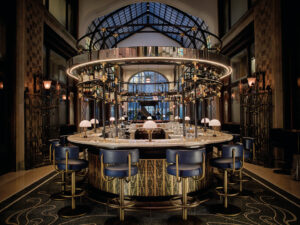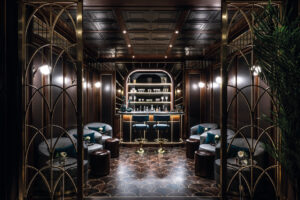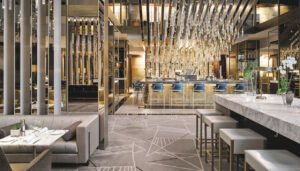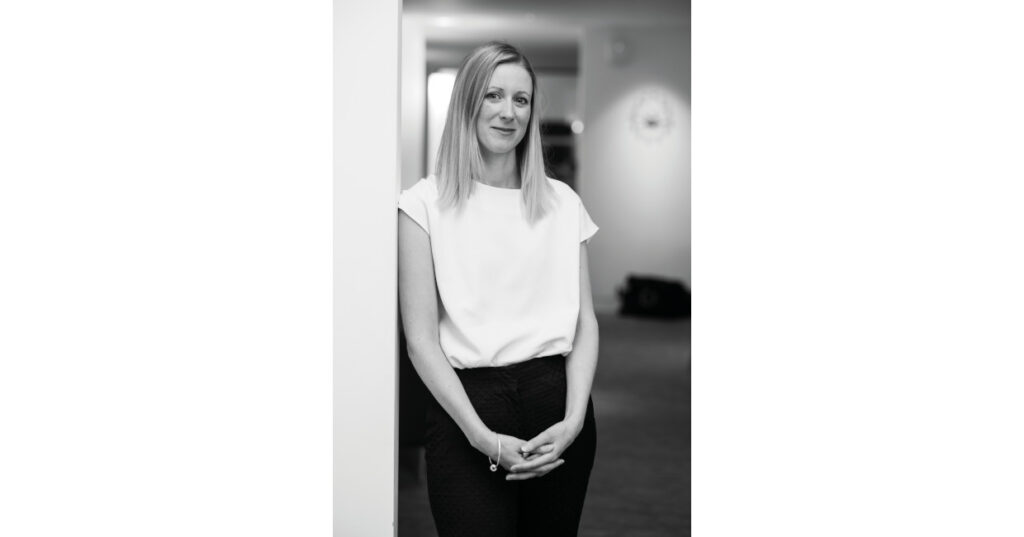Award-winning studio Richmond International is best known for its distinctly luxurious designs within the hotel and cruise circuit. Determined that sustainability will become part of the company’s repertoire, Amy Roebuck tells Sophie Harper about her hopes for the future of design.
Having studied textile design at Manchester Metropolitan University following an art foundation, Amy Roebuck tells me how she came to interior design from a somewhat sideways angle. “Textiles was my thing, I did a lot of freelance work following university and even had my own collection, which sold quite well in America.”
Amy was designing textiles for the interiors market at the same time so, after taking some time out to travel, decided to spend more time learning about the interior design sector. “I had this newfound sense of confidence following my travels and I went to this design studio in Newcastle and asked for an internship. They thought I was 17, but actually I was 25! Anyway, I was there for two years and learnt a lot. It was a small studio and they only did residential projects, but it was a great team and they answered all my questions. I moved to London after that and that’s really where things took off.”

Amy worked at KDA for five years before finding her current home at Richmond International. “I initially thought I wanted to stay with residential because that’s what I knew, but I made the switch to hospitality and the rest is history,” she tells me, beaming. “I absolutely love designing for hospitality – there’s not a boring minute in my day! Richmond is a great company, we’re like a family – people stay here – I’ve been here 11 years but a lot of my colleagues have been here much longer.”
Beginning her career at Richmond as a mid-weight designer, Amy worked her way up to senior, then project lead, and now senior associate. And as though she didn’t have enough on her very full plate, she’s taken it upon herself to spearhead the company’s sustainability drive. “During Covid I took more of an interest in sustainability and started doing a lot of reading on the subject, doing a lot of research in the form of information gathering, and I felt I wanted to do something better,” she says. “I love being a designer and designing beautiful spaces, but I wanted to figure out how I could be doing something good at the same time. So, when the opportunity presented itself at Richmond, I held up my hand and said I’ll do it!”
“I try to drive the initiatives forward, but a lot of what I’m doing is learning through research, going to seminars, performance moderating, collaboration and partnerships with suppliers, and innovation – as technology advances, so do the opportunities to do more.”
Amy tells me a lot of the conversations she’s been having centre around what sustainability actually means within the industry and whether it can go hand-in-hand with luxury design. “We have to work out how to apply that to a hotel and I think a lot of it comes down to changing your mindset. Sustainability isn’t just about the material, it’s about social economics and the community – you have to be in tune with what’s local to each project, be mindful of the culture, use local materials, work with the people. There’s a lot of focus on using natural materials but it goes way beyond that. Choosing wood over concrete is all well and good, but where is it being sourced from? Are you shipping American walnut over to Europe when there’s perfectly good walnut over here already? Working with local craftspeople is a great way to gain knowledge of the natural materials in the immediate vicinity as well – and they know exactly how to use it – and that’s invaluable. It’s about building and making things that will last, longevity should have more of a focus – we still have too much of a throwaway attitude.”

She talks about the challenges designers face when it comes to sustainability and says that one of the main issues is that there’s no legislation in place for interiors. “Architects and the construction side of things have much clearer guidance. Construction counts for around 40% of a building’s carbon footprint, so there’s been a lot more research. Sustainability is a very complicated and multifaceted subject. While there are certificates for sustainable buildings such as BREEAM, LEED, WELL, there aren’t any formal assessments for interiors, we’re having to play catch-up and do the best we can with an awful lot of information. We do a lot of our own research, but when you delve into it there’s a lot of greenwashing – so for us sustainability is a journey rather than a destination.”
Of course, the studio has always had a good relationship with manufacturers and Amy tells me how they’re instrumental in helping designers make good choices, but that there’s plenty of scope to switch things up. “We’ve always worked with the best suppliers in the industry, we’ve always valued good craftsmanship and longevity, but we need to be looking at the way products are manufactured and make a shift with some of the materials that are used.”
Passionate about the ways in which things are taking a seismic shift for the better, Amy says she’s hopeful that everyone will embrace the changes, but that there’s a lot we still need to do to ensure the industry as a whole is going in the right direction. “I think as designers in this industry it’s crucial we recognise our responsibility to do more to produce a more sustainable end product. The hospitality industry has a significant environmental impact but it has the potential to contribute positively in terms of sustainable outcomes. By us actively incorporating better practices into our operations and design decisions we could substantially reduce the industry’s environmental footprint – as designers we have a duty to do everything we can.”

Currently, Richmond International is collating all the information it needs to fully structure its sustainable framework and Amy tells me about some of the areas they’re focusing on. “We constantly need to look for ways to improve and we’ll do that by looking at energy efficient lighting, sustainable material selection, water use, conservation, environment, waste management, and sustainable furniture and fittings.”
“We’re building our own framework and our own roadmap that will eventually be implemented across all our projects. We’re looking at collaborating with experts to assist us with this process and our aim is to become carbon net zero. The only way you can make changes is by setting targets, so we’re looking at annual targets to keep us on track and to gauge our progress.”
Amy tells me how she’s looking forward to hearing more about innovative and adaptive design solutions centred around sustainability. “The hospitality industry and technology is always evolving. In the future I hope human-centric design that sees spaces created to prioritise the wellbeing and inclusivity of guests is matched with the seamless integration of sustainability and hope that becomes the fundamental aspect of design.”



